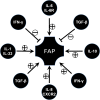Immune Microenvironment: New Insight for Familial Adenomatous Polyposis
- PMID: 33628741
- PMCID: PMC7897671
- DOI: 10.3389/fonc.2021.570241
Immune Microenvironment: New Insight for Familial Adenomatous Polyposis
Abstract
Currently, the main treatment for familial adenomatous polyposis (FAP) is surgery, however, surgery is far from ideal as there are many complications such as uncontrollable bowel movements, pouch inflammation, anastomotic stricture, and secondary fibroids. Therefore, it is necessary to further expand the understanding of FAP and develop new treatments for FAP. The immune microenvironment including immune cells and cytokines, plays an important role in FAP and the progression of FAP to adenocarcinoma, thus it may be a promising treatment for FAP. In the current review, we summarized the recent progress in the immune microenvironment of FAP.
Keywords: FAP; colorectal cancer; cytokines; immune cells; immune microenvironment.
Copyright © 2021 Yang, Wen, Li, Sun, Ma, She, Zhang, Tu, Wang, Huang, Shen, Dong and Zhang.
Conflict of interest statement
Authors HSZ, XKS, GW, XS, and DH are employed by the company 3D Medicines Inc. The remaining authors declare that the research was conducted in the absence of any commercial or financial relationships that could be construed as a potential conflict of interest.
Figures



Similar articles
-
Cancer in an unexpected site post pouch surgery for familial adenomatous polyposis (FAP).Int J Surg Case Rep. 2018;42:266-268. doi: 10.1016/j.ijscr.2017.12.037. Epub 2017 Dec 28. Int J Surg Case Rep. 2018. PMID: 29324375 Free PMC article.
-
Efficacy and safety of eflornithine (CPP-1X)/sulindac combination therapy versus each as monotherapy in patients with familial adenomatous polyposis (FAP): design and rationale of a randomized, double-blind, Phase III trial.BMC Gastroenterol. 2016 Aug 2;16(1):87. doi: 10.1186/s12876-016-0494-4. BMC Gastroenterol. 2016. PMID: 27480131 Free PMC article. Clinical Trial.
-
The genetic basis of colonic adenomatous polyposis syndromes.Hered Cancer Clin Pract. 2017 Mar 16;15:5. doi: 10.1186/s13053-017-0065-x. eCollection 2017. Hered Cancer Clin Pract. 2017. PMID: 28331556 Free PMC article. Review.
-
Is laparoscopic surgery an option to support prophylactic colectomy in adolescent patients with Familial Adenomatous Polyposis (FAP)?Pediatr Blood Cancer. 2012 Dec 15;59(7):1223-8. doi: 10.1002/pbc.24113. Epub 2012 Feb 29. Pediatr Blood Cancer. 2012. PMID: 22378577
-
Adenomatous Polyposis Syndromes: Diagnosis and Management.Clin Colon Rectal Surg. 2016 Dec;29(4):321-329. doi: 10.1055/s-0036-1584089. Clin Colon Rectal Surg. 2016. PMID: 31777463 Free PMC article. Review.
Cited by
-
In silico identification of novel biomarkers for key players in transition from normal colon tissue to adenomatous polyps.PLoS One. 2022 Apr 29;17(4):e0267973. doi: 10.1371/journal.pone.0267973. eCollection 2022. PLoS One. 2022. PMID: 35486660 Free PMC article.
-
NF-κB Activator 1 downregulation in macrophages activates STAT3 to promote adenoma-adenocarcinoma transition and immunosuppression in colorectal cancer.BMC Med. 2023 Mar 29;21(1):115. doi: 10.1186/s12916-023-02791-0. BMC Med. 2023. PMID: 36978108 Free PMC article.
-
The Effect of Salmonella AvrA Infection on Colon Cancer: An in-silico Study.Asian Pac J Cancer Prev. 2023 Jan 1;24(1):163-170. doi: 10.31557/APJCP.2023.24.1.163. Asian Pac J Cancer Prev. 2023. PMID: 36708565 Free PMC article.
-
The Adaptive Immune Landscape of the Colorectal Adenoma-Carcinoma Sequence.Int J Mol Sci. 2021 Sep 10;22(18):9791. doi: 10.3390/ijms22189791. Int J Mol Sci. 2021. PMID: 34575971 Free PMC article.
-
Antitumor efficacy of intermittent low-dose erlotinib plus sulindac via MHC upregulation and remodeling of the immune cell niche.Int J Cancer. 2025 Jul 15;157(2):355-370. doi: 10.1002/ijc.35409. Epub 2025 Mar 12. Int J Cancer. 2025. PMID: 40072251 Free PMC article.
References
Publication types
LinkOut - more resources
Full Text Sources
Other Literature Sources
Miscellaneous

